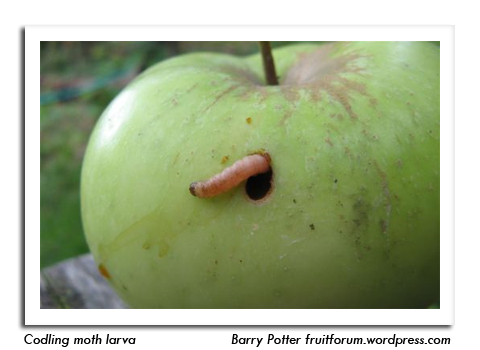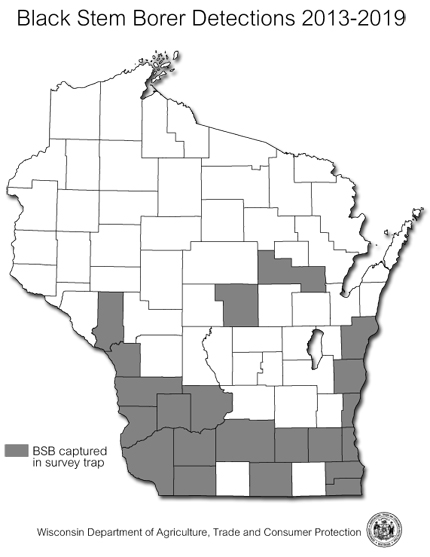
 |
|
|
Fruits
Volume 64 Number 19 Date 11/07/2019 BROWN MARMORATED STINK BUG - Monitoring for this emerging pest was carried out at 59 sites this season. DATCP cooperators, the UWEX Door County Agriculture agent, and two IPM Institute consultants set clear sticky panel traps in 39 apple orchards, 12 vineyards and 8 cherry orchards. Ten trap locations in Dane, Lafayette, Racine, Richland, Rock and Walworth counties were positive for BMSB. The season's highest count was 62 BMSB adults and nymphs on a trap near Janesville. Rock County is one of several counties, along with Brown, Dane, Fond du Lac, Milwaukee, Outagamie, Waukesha, and Winnebago, where densities are high enough that BMSB has become an urban nuisance. The two new additions to the Wisconsin BMSB distribution map this year were Dodge and Lafayette counties. Thirty of the state's 72 counties are now known to be infested with BMSB. CODLING MOTH - Abnormally cold weather and heavy rains delayed codling moth emergence in 2019. The first moths were trapped on May 23, though initial flights were light and inconsistent, and the spring biofix was not set at most monitoring sites until May 31-June 6. Treatments targeting first-generation larvae began during the week of June 23. Summer moths appeared around mid-July and large flights (15-37 moths) continued throughout August. The high summer codling moth pressure in some orchards was an indicator of the ineffective spring generation control due to mistimed applications and/or rain diluting larvicide coverage during the June treatment window. Codling moth flights continued into September, with additional late-season spot treatments required for several sites. BLACK STEM BORER - The Asian ambrosia beetle Xylosandrus germanus was identified on June 4 in an apple tree in a Lafayette County orchard. According to the orchard owner's report, the trunk of the infested tree had at least 20 borer with protruding frass columns indicative of ambrosia beetle infestation. Black stem borer attacks a wide range of fruit trees and hardwoods and has been documented by DATCP in 21 Wisconsin counties since 2013. Until the Lafayette County report, there had been no confirmed cases of apple tree damage in the state. Orchards in Michigan, Ohio and other northeastern states have had issues with this pest in the last few years, and in western New York, the beetles have reportedly killed large numbers of apple trees. SPOTTED WING DROSOPHILA - The first SWD flies of the season were captured in DATCP traps on June 19 in La Crosse County. This date compares to June 1 in 2018, June 5 in 2017, and June 10 in 2016. Significant SWD fly captures were reported during the last week of June at monitoring sites, and larvae were noticeable in raspberries and other small fruits by mid-July. EUROPEAN CHERRY FRUIT FLY - A pest detection survey was conducted on the Door Peninsula of northeastern Wisconsin in 2018 and 2019 for the European cherry fruit fly (ECFF), Rhagoletis cerasi. First found in North America in Ontario in 2015 and two years later in New York, ECFF is a pest of economic and quarantine significance that poses a high risk to Door County's $1.9 million dollar tart cherry crop. Surveys for ECFF were conducted at eight orchards, and included the placement of four yellow sticky traps (32 traps total) baited with ammonium carbonate attractant at each location. No ECFF were captured on any of the traps in either season. APPLE MAGGOT - Emergence of flies began in orchards by July 10, two weeks later than in 2018. Counts peaked during the week of July 25-August 7 at most southern and central sites. A few orchards also reported high counts (5-11 per trap) during the last week of August. The season's highest count was 17 flies on a red sphere trap in Crawford County. -- Krista Hamilton, DATCP Entomologist VELVET LONGHORNED BEETLE - A third year of survey work was carried out in 2019 in response to the recent discovery of this potential fruit and landscape tree pest in Milwaukee County. The velvet longhorned beetle (VLB), like other invasive wood-borers, can be harbored in firewood and wood shipping crates and cargo, including furniture. It has been intercepted at many ports and warehouses across the U.S. since 2002. The first Wisconsin detection of VLB occurred in 2017 and surveys in 2018 collected a total of 75 beetles in nine Milwaukee County traps, all near Mitchell International Airport. This year's survey in 14 counties captured 22 beetles in eight traps. The positive traps were in Milwaukee County where VLB is now established, as well as in three new counties: Fond du Lac, Kenosha and Waukesha. -- Renee Pinski, DATCP Forest Entomologist STRAWBERRY LEAF SPOT - Cool, wet spring weather contributed to development of this disease on strawberry plants. Strawberry leaf spot, caused by the fungus Mycosphaerella fragariae, results in stunting, leaf drop, and plant mortality. The positive samples were collected from farms in La Crosse, Pierce, and Sauk counties, though this disease was undoubtedly much more common this season. GRAPE DISEASES - Grape anthracnose, downy mildew and powdery mildew were confirmed on grape foliage from multiple counties surveyed by collaborators from the IPM institute this season. Disease samples were collected from vineyards in Brown, Dane, Outagamie, Richland, Trempealeau, Vernon and Winnebago counties. -- Anette Phibbs, DATCP Plant Pathologist APIARY INSPECTIONS - Apiary inspectors visited 204 beekeepers this year, opening 3,398 hives for inspection. Based on these voluntary inspections, winter mortality decreased for the second year in a row from 47% in 2017-18 to 32% in 2018-19, which is slightly lower than the 38% national average winter loss for beekeepers during the same time period. Varroa mite was detected in 51% of hives sampled for this pest, compared with 58% last season. Other pests and diseases found include American foulbrood in 0.7% of hives, chalkbrood in 5.9% of hives, European foulbrood in 6.4%, deformed wing virus in 11.8%, sacbrood in 4.8%, and small hive beetle in 6.3% of hives. Inspectors issued 59 apiary inspection certificates for 39,815 migratory hives, primarily destined for California, Florida and Texas to be used for pollination services. -- Liz Meils, DATCP Nursery Inspector 





|
|
|